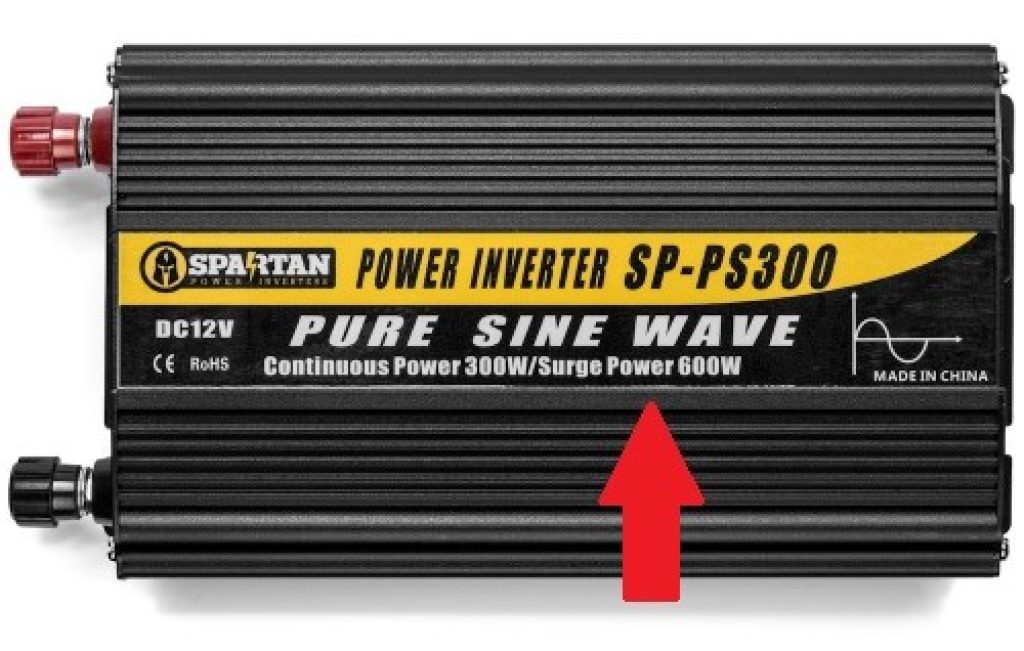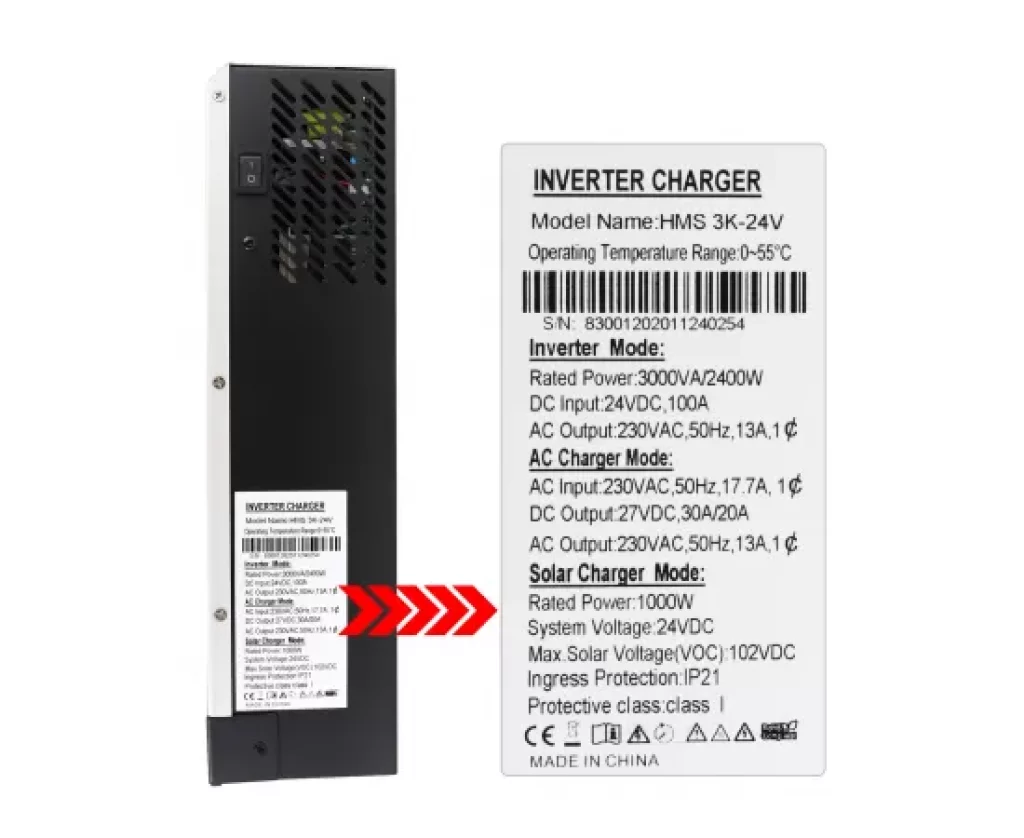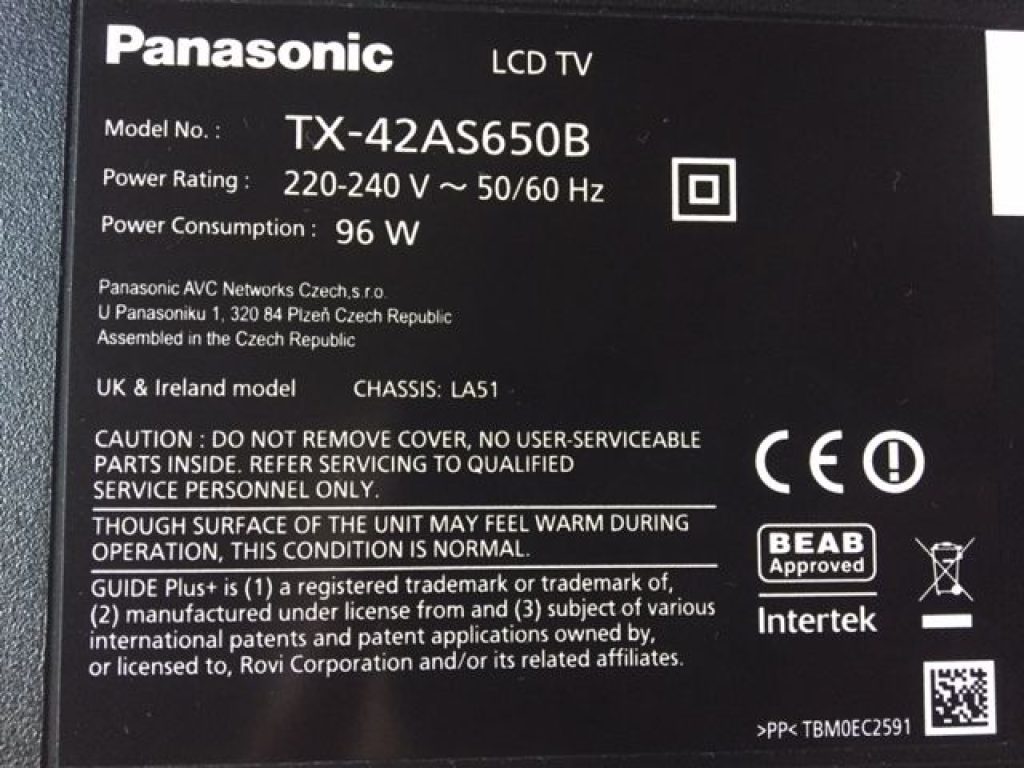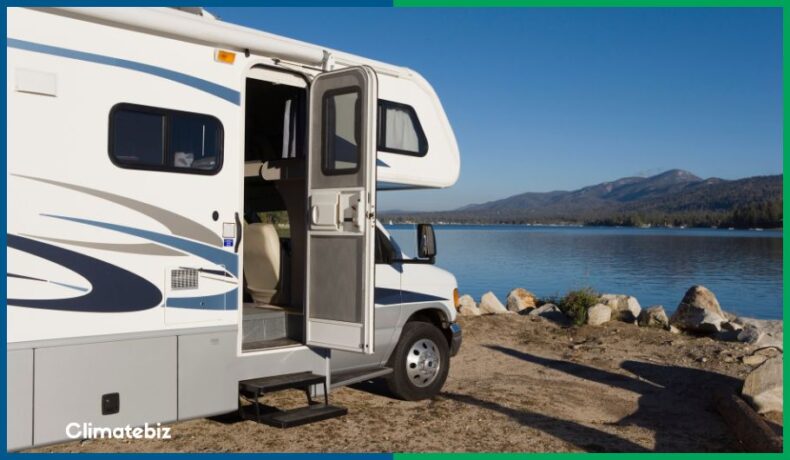Figuring out what’s the right inverter size for your RV can be a difficult step when setting up your RV power system. But don’t worry, we’re here to help!
Having an off-grid inverter in your RV is the best option for those seeking freedom on the road.
It allows you to boondock in secluded places, with amazing views – away from campgrounds and RV parks – while still having enough power to run all your essential appliances.
However, having the wrong size inverter can turn your relaxing family getaway into a real headache, with not enough AC power to run all your RV appliances.
Therefore, sizing your inverter properly is crucial to ensure that your power system meets your demands.
In this article, we’ll provide a detailed explanation of how to size your RV inverter – from estimating your power needs to determining which inverter size will meet your needs.
Additionally, we’ll provide an inverter chart showing what you can power with different inverter sizes.
Table of Contents
Inverter Size Chart For RV
| Inverter Size | LED Light (9 W) | Wi-Fi Router (10 W) | Phone Charger (5 W to 20 W) | Tablet Charger (10 W to 30W) | Drone / Camera Charger (40 W) | Laptop Charger (60 W to 100W) | Electric Fan (60 W) | Small Portable Fridge (85 W) | Water Filter Cooler (90W) | Water Pump (100W) | TV 50″ (150W) | Medium Fridge (150W to 300W) | Large Fridge with Freezer (400 W to 500W) | Blender (600 W to 800W) | Hair Dryer (1000 W) | Microwave (1300 W) | Vacuum Cleaner (1400 W) | Washing Machine (1400 W) | Coffee Maker (1400W to 1500W) | Portable Heater (1500 W) | AC unit (1600 W) | Air Fryer (1700 W) | Dryer (2300 W) |
|---|---|---|---|---|---|---|---|---|---|---|---|---|---|---|---|---|---|---|---|---|---|---|---|
| 500 W | ✔ | ✔ | ✔ | ✔ | ✔ | ✔ | ✔ | ✔ | ✔ | ✔ | ✔ | ✔ | ❌ | ❌ | ❌ | ❌ | ❌ | ❌ | ❌ | ❌ | ❌ | ❌ | ❌ |
| 700 W | ✔ | ✔ | ✔ | ✔ | ✔ | ✔ | ✔ | ✔ | ✔ | ✔ | ✔ | ✔ | ❌ | ❌ | ❌ | ❌ | ❌ | ❌ | ❌ | ❌ | ❌ | ❌ | ❌ |
| 1000 W | ✔ | ✔ | ✔ | ✔ | ✔ | ✔ | ✔ | ✔ | ✔ | ✔ | ✔ | ✔ | ✔ | ❌ | ❌ | ❌ | ❌ | ❌ | ❌ | ❌ | ❌ | ❌ | ❌ |
| 1500 W | ✔ | ✔ | ✔ | ✔ | ✔ | ✔ | ✔ | ✔ | ✔ | ✔ | ✔ | ✔ | ✔ | ✔ | ✔ | ❌ | ❌ | ❌ | ❌ | ❌ | ❌ | ❌ | ❌ |
| 2000 W | ✔ | ✔ | ✔ | ✔ | ✔ | ✔ | ✔ | ✔ | ✔ | ✔ | ✔ | ✔ | ✔ | ✔ | ✔ | ✔ | ❌ | ❌ | ❌ | ❌ | ❌ | ❌ | ❌ |
| 2500 W | ✔ | ✔ | ✔ | ✔ | ✔ | ✔ | ✔ | ✔ | ✔ | ✔ | ✔ | ✔ | ✔ | ✔ | ✔ | ✔ | ✔ | ✔ | ✔ | ✔ | ❌ | ❌ | ❌ |
| 3000 W | ✔ | ✔ | ✔ | ✔ | ✔ | ✔ | ✔ | ✔ | ✔ | ✔ | ✔ | ✔ | ✔ | ✔ | ✔ | ✔ | ✔ | ✔ | ✔ | ✔ | ✔ | ✔ | ❌ |
| 3500 W | ✔ | ✔ | ✔ | ✔ | ✔ | ✔ | ✔ | ✔ | ✔ | ✔ | ✔ | ✔ | ✔ | ✔ | ✔ | ✔ | ✔ | ✔ | ✔ | ✔ | ✔ | ✔ | ✔ |
What Size Inverter Does My RV Need?

Inverters are sized by wattage and come in a wide variety of sizes.
The most common inverter size used in standard RVs is 2000 watts, but it can range from 1500 W to 3000 W depending on how many appliances you have in your RV and how much power your appliances draw.
A 2000 W inverter is the most common size because it is enough to power all your typical “power-hungry” appliances, such as a residential fridge, a microwave, and a coffee maker (not all three simultaneously).
However, installing the most common inverter size in your RV might not be what’s best for you. If it’s too little, you won’t be able to power some of your appliances, and if it’s too big, you’ll be wasting energy to power an inverter that’s too powerful for your needs.
So to avoid any unwanted surprises, we’ll show you how to estimate what inverter size you need for your RV, according to your specific power needs.
Related Reading: What Will A 200 Watt Solar Panel Run In An RV?
What Appliances Do You Want To Power In Your RV?
First, you need to know which devices and appliances in your RV you’re going to power simultaneously (for example a fridge, TV, electric fan, and laptop charger will probably run at the same time).
For this, make a list of the appliances you have in your RV and how much power they consume (in watts). Add up the watts of the appliances you think are likely to run at the same time.
This will help you determine which size inverter you’ll actually need (it should be large enough to handle all the appliances running simultaneously).
Surge Power
When selecting an inverter for your RV, you should not only consider the running power of your appliances but also their surge power.
Some appliances like microwaves and refrigerators will draw a high amount of power (hence “surge power”) for a few seconds when they first startup.
Therefore, when searching for inverters you’ll notice that they’re rated by how many watts they can provide continuously and by their surge capacity, that is, the maximum power they can provide for a few seconds in order to start some appliances.

Source: spartanpower.com/
Usually, pure sine wave inverters have a surge capacity that’s double their continuous power output, so if your inverter is big enough to handle all your appliances given their running power, it should also be able to handle their surge power.
Related Reading: Are Solar Panels On An RV Worth It?
What’s Your Biggest Power Draw?
There’s no need to get an inverter large enough to power all your RV appliances (considering the sum of their power ratings) if you’re not going to use them all at the same time.
If you understand your largest loads and how often you will be running them, you can get a smaller inverter, saving money and energy (the inverter itself requires energy to work).
For example, if you have a 2000 W inverter, you might have to turn off some of your other appliances before running a microwave.
However, if you don’t want to worry about this, consider getting a larger inverter, one that can handle all your appliances simultaneously.
Are There Drawbacks to Larger Inverters?
An inverter is just like any other device, it consumes energy in order to work. Even at idle it will consume energy from your battery (or any other source of DC power).
Needless to say, the larger the inverter the more energy it will consume.
Therefore, by oversizing your inverter you might be wasting your limited energy on something that you don’t even need.
Not to mention the price difference and the fact that large inverters are less efficient if used only for light loads (if the continuous power is below 10-15% of the inverter’s capacity, efficiency is quite low).
For these reasons, avoid oversizing your inverter. Get an inverter that’s big enough to meet your power requirements, but of course, always consider the inverter’s inefficiencies (that is, always have a bit of wiggle room).
Related Reading: BougeRV 200W Solar Panel Review
Consider Inefficiencies And Inductive Loads
No inverter is 100% efficient. That is, a 2000W inverter won’t be able to provide exactly 2000W of continuous power.
What’s more, inverter efficiency depends on inverter load. For instance, when the output power is less than 10% of the inverter’s rated capacity, efficiency will be quite low.
Similarly, if the output power it’s over 80% of your inverter’s rated capacity, efficiency will begin to drop significantly.

Source: e-education.psu.edu/
In addition, inductive loads such as power tools, refrigerators, and air conditioners may use up to 40% more than their rated power.
Therefore, to account for these inefficiencies/losses, once you’ve added up the number of watts you’ll need to power your appliances, add an extra 40% (multiply the total power by 1.4).
Here’s a formula you can use to size your RV inverter:
Inverter Size (W) = Total power consumed by appliances (W) x 1.4
This should tell you the minimum size inverter you’ll need to safely power your RV’s appliances.
Example
Let’s say you’re planning on running your fridge (180 W), TV (150 W), electric fan (60W), and phone charger (10 W) at the same time.
The total power consumed by these appliances is:
Total power (W) = 180 W + 150 W + 60 W + 10 W = 400W
Therefore, considering system inefficiencies, the minimum size inverter you’ll need to safely power these appliances is:
Inverter Size (W) = Total power consumed by appliances (W) x 1.4
Inverter Size (W) = 400 W x 1.4 = 560 W
Related Reading: RV Solar System (Complete Guide To Going Off-Grid)
Determine Your Inverter’s DC Input And AC Output Voltage
Inverters convert DC power from a DC source (like solar batteries or PV modules) into AC power (used by most appliances).
Therefore, you need to consider the DC input and AC output voltage of your inverter to match your requirements.
For instance, what’s the voltage of your DC power source? 12V, 24V, or 48V? The input voltage (DC power) of your inverter should be the same as the output voltage of your energy storage system (such as your RV batteries).
In addition, the inverter’s AC output power needs to match that of your appliances, which can be 120 V or 240 V.
Once you’ve figured out your voltage requirements, you can search for an inverter with those specs.

Notice that the DC input voltage is 24 V
and the AC output voltage is 230 V.
Source: powmr.com/
How To Estimate Your RV Power Needs
Estimating your RV power needs is crucial in order to determine what inverter size is right for your RV.
The general idea is that your RV inverter needs to be big enough to handle your power demands. In other words, it needs to be able to provide enough continuous AC power to run all of the appliances that you wish to run simultaneously.
Although it may seem complicated at first, it is actually quite simple. Simply follow the steps below:
1. Check Your Appliances Power Rating (in Watts)
The first thing you need to do is check your appliances’ power consumption (wattage), expressed in watts (W).
You’ll probably find it in the appliance’s datasheet or in a label located at the back/bottom of the appliance.
If the power isn’t mentioned (but voltage and current are), you can calculate it using the following formula:
Power (W) = Voltage (V) x Current (A)

We recommend making a list of all your RV’s appliances, as well as their power consumption.
Please note: to size an inverter, we only need to know the appliance’s power consumption (in watts), and not its energy consumption (in Wh). Power and energy are different – yet related – concepts.
Related Reading: How Many Solar Panels Are Needed For An RV?
2. Calculate The Total Power Consumption
Once you’ve made a list of all your RV appliances and their power rating, you can now calculate the total power consumption of your RV.
For this, you need to consider all the appliances you’ll be running simultaneously.
Example
If you think that, at some point, you’ll be running your fridge (180 W), microwave (1400 W), TV (100 W), Wi-Fi router (10 W), water pump (100 W), and laptop charger (50 W) at the same time, you should add up all the power ratings for these appliances, like so:
Total Power Needed (W) = 180 W + 1400 W + 100 W + 10 W + 100 W + 50 W = 1840 W
3. Account for Inefficiencies
Remember, once you’ve estimated your power needs, account for inefficiencies/discrepancies when sizing your inverter.
For this, simply add an extra 40 % to the total wattage you’ve calculated.
Example
Let’s say you want to run your TV (150 W), microwave (1400 W), and laptop charger (50W) at the same time. That’s a total of 1,600 W:
Total power consumption (W) = 150 W + 1400 W + 50 W = 1600W
To account for inefficiencies, we apply the formula provided previously, in this article:
Inverter Size (W) = Total power consumed by appliances (W) x 1.4
Inverter Size (W) = 1600 W x 1.4 =2240 W
Therefore, you’d need an inverter of at least 2240 W (a 2500 W inverter would be ideal).
Why Do I Need An Inverter For My RV?
In short, inverters convert DC power (supplied by the batteries in your RV) into AC power (used by your appliances).
“Ok… But why is that important?”
When you park your RV in a campground and connect it to shore power, you’re getting the same type of power as you get when you plug in an appliance in one of your home’s wall outlets: AC power.
However, when you’re off-grid, you’re most likely getting your power from a battery, and this is where things get a bit complicated: batteries do not supply AC power like your home’s outlets. Instead, batteries supply DC power.
So if AC is the type of electric current used to run virtually all of your appliances, how can you use the DC power from your batteries to run your appliances?
Well, this is exactly why you need an inverter in your RV.
By converting AC into DC, inverters allow you to use the DC power from your batteries to power all of your AC appliances!
If you want to learn more about how inverters work, here’s an interesting video:
Difference Between AC And DC
AC stands for Alternating Current, which is the type of electric current used by virtually all of your home’s appliances.
The other type of current is the Direct Current (DC). This type of current is largely used by electronic devices, such as cellphones, laptops, and pretty much anything with a battery in it.
While Alternating Current (AC) periodically reverses direction and changes its magnitude continuously with time, Direct Current (DC) flows in only one direction.
Why Is DC to AC Conversion Necessary?
As previously said, AC is used by virtually all of your home’s appliances.
Most devices are simply designed to run on AC power since the supply of AC power has been the norm for several decades.
Now here’s a fun fact: the chargers you use to charge the batteries in your phone, laptop, electric vehicle, etc., actually do the opposite of an inverter. They convert the AC power from your wall outlet into DC power.
Seems a bit inefficient, right?
This happens because, due to its high voltage, AC energy can be transmitted through power lines more efficiently than DC energy, reducing the energy lost as heat (caused by the resistance of the wire).
For this reason – and the fact that it is less costly – AC energy became the global standard.
Final Thoughts
If you plan on spending time off-grid in your RV, you’ll definitely need an inverter.
Luckily, choosing the right inverter size for your RV is not as difficult as it may seem.
The main thing you should do is check the power consumption of your RV’s appliances and make sure that the total wattage of the appliances you’re running at the same time (plus an extra 40%) fits into the inverter’s rated capacity (in watts).
In summary, here are the key points to consider when sizing an inverter for your RV:
- The appliances you’re going to power in your RV
- Your biggest power draw
- Surge power
- DC input voltage
- AC output voltage
- Inverter’s wattage rating
- You power demands
- The type of inverter (pure sine wave inverters are recommended for most cases)
- Inefficiencies (apply our formula for sizing your inverter)
Once you’ve figured out your needs, you can start searching for the perfect inverter for your RV!

